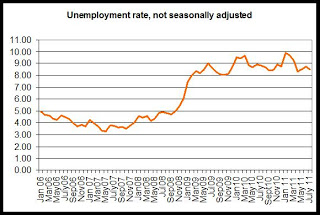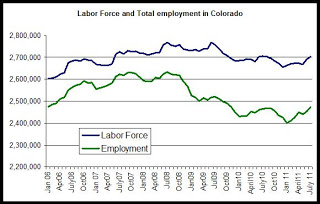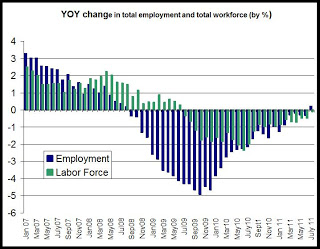
From July 2010 to July 2011, total employment rose 0.22 percent, while the labor force shrank 0.08 percent. The total labor force in July included 2.701 million workers.
As can be seen in the second graph, total employment and total workforce size have increased month-over-month. Year over year, total employment rose while the labor force grew smaller. Both remain well below the July 2008 peak.

The employment total is 161,000 jobs below the peak levels experienced during July 2008 when there were 2.63 million employed workers. Compared to the labor force peak in July 2008, the labor force is now down by more than 66,000 workers.
In the third graph is shown the year-over-year comparisons, by percent, for total employment. July 2011 was the first month in 34 months that showed a positive change in year-over-year employment comparisons. Between August 2008 and July 2011, no month posted a positive change in total employment when compared to the same month a year earlier. Although overall total employment has increased since January 2010, employment totals remain negative in each year-over-year comparison.

The graph also shows the year-over-change in total employment. Total labor force size has fallen more than employment in the last five months, which helps to explain the drop in the unemployment rate. Although the state had not actually added jobs in the YOY comparisons between August 2008 and July 2011, the number of people looking for work (as defined by the Household Survey) has declined, pushing the unemployment rate down in recent months.
These numbers come from the Household Survey employment data, so the size of the workforce is dependent on the number of people stating that they are actively looking for work if not employed. Discouraged workers who have stopped looking for work are excluded.
0 comments:
Post a Comment